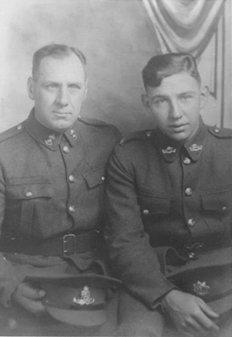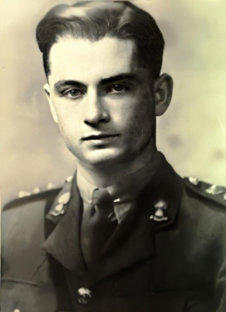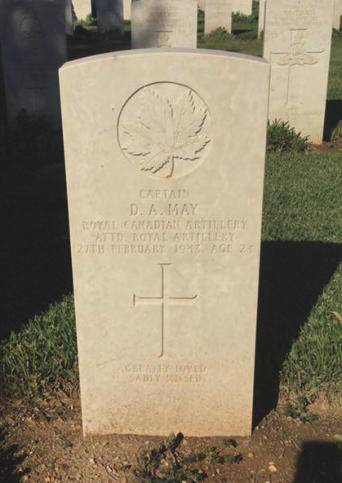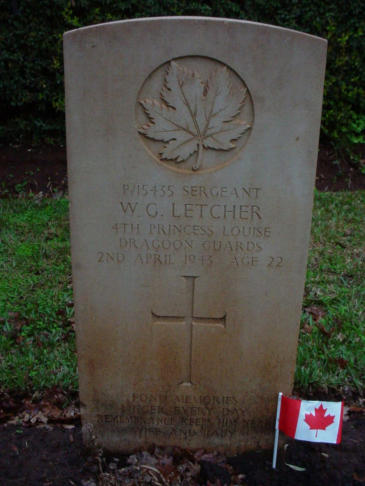
copyright © Wartime Heritage Association
Website hosting courtesy of Register.com - a web.com company
Wartime Heritage
ASSOCIATION
Remembering World War II
Nova Scotian British Army Casualties - Tunisia
Prior to the more formal adoption of the CANLOAN program which saw Canadian officers lent to the British Army to supplement their
forces, Canadian officers were already being transferred to British Army units as demand necessitated. This allowed them to gain
valuable experience for the fight ahead in Europe. (The CANLOAN Program - Nova Scotian Casualties)
Of those who served in North Africa, two men with ties to Nova Scotian died serving with the British Army: Sergeant William
Granville Letcher and Captain David Arthur May.
On November 8, 1942, came the Allied landings in French North Africa. No Canadian units as such took part in this great operation;
the British troops sent from the United Kingdom were the First Army, commanded by Lieutenant-General K. A. N. Anderson.
However, the campaign in Tunisia which followed offered an opportunity for giving battle experience to selected Canadians and on
this, Canadian General McNaughton seized.
An arrangement was made for the immediate attachment to the First Army of 78 officers and 63 non-commissioned officers (NCOs),
who reached Algiers early in January 1943. They were treated as though they had been normal British reinforcements and were
“posted” to appropriate units. That is to say, a Canadian infantry Captain or Major might (and often did) find himself commanding a
company of a British battalion; a Canadian medical officer might be placed in charge of a section of a Field Ambulance of the Royal
Army Medical Corps; while a Sergeant of the Royal Canadian Corps of Signals might be found performing the responsible duties of his
rank in a Brigade Signal Section. At the time when these Canadians arrived, the First Army was hard pressed. It consisted of only two
British divisions, the 78th Infantry Division and the 6th Armoured Division. Most of the Canadians were assigned to these formations,
and they saw plenty of service, for there were many casualties to be replaced. At one point an infantry unit of the 6th Armoured
Division had a Canadian second-in-command and three Canadian company commanders.
Further groups of Canadians were subsequently dispatched to Africa, the procedure continuing until the end of the campaign. In all,
201 officers and 147 NCOs were sent out for three-month periods, and what they learned was invaluable. However sound mere
training may be, there is no final substitute for battle experience. These men, returning to England, brought a most useful leaven of
such experience to the Canadian Army. The active manner in which they had been employed was reflected in their losses. Fourteen
officers and 11 other ranks became casualties during the North African campaign. Four officers and four other ranks lost their lives.
It was not junior leaders only who profited by African experience. In February of 1943 Canadian General Crerar, with a group of
British generals, flew out from England and attended a four-day study period at General Montgomery’s headquarters. In April,
Canadian Brigadier GG Simonds went out similarly and watched the Wadi Akarit battle from the headquarters of the Eighth Army and
of the 10th Corps. Immediately after his return, he was appointed to command the 2nd Canadian Division in succession to General
Roberts (who now assumed command of the Canadian Reinforcement Units) ; but a few days later, following the death in an aircraft
accident of Major General H. L. N. Salmon, who had succeeded General Pearkes in the command of the 1st Division, General
Simonds was transferred to that Division and found himself a prospective divisional commander in the Eighth Army, which he had so
lately visited.
Sergeant William Granville Letcher
Service No. P/15435
William was born 18 October 18, 1920, in Springhill, Cumberland County, Nova
Scotia, the son of Charles Burrows Letcher (1899-1966) and Mary Triffenia (Legrow)
Letcher (1902-1984), of Springhill, Nova Scotia, the brother of six siblings, and the
husband of Doris Muriel (Dyke) Letcher (1924-2003), also of Springhill. They had a
daughter Muriel Jean Letcher born November 13, 1942.
William was employed as an electrical engineer before the war.
In William’s case, he first served with the Nova Scotia Highlanders as of July 20,
1939, until he re-attested with the Royal Canadian Regiment for Active Service in
WWII on September 6, 1939.
He embarked at Halifax December 18, 1939, and disembarked in Gourock, Scotland
in the UK on December 30, 1939.
In the UK he was first assigned to the 1st Canadian Reconnaissance (Recce) Squadron
before additional training and transferring to the 4th Recce Regiment of the 4th
Princess Louise Dragoon Guards. He embarked in the UK for North Africa on
February 21, 1943, and was attached to the 46th Reconnaissance Regiment of the
British Army at the same time.
Sergeant William Granville Letcher was killed in action on April 2, 1943 (age 22) while serving with the 46th Recce
Regiment in Tunisia.
William Letcher was initially buried at the Sedjenane Cemetery and is now interred at the Tabarka Ras Rajel War
Cemetery (Section 3, Row E, Grave 2), in Tunisia. On his headstone, his family chose the personal inscription, “Fond
memories linger every day, remembrance keeps him near. Wife and baby”
There is a memorial to the Reconnaissance Corps and the 46th Recce Regt. in the Allied Special Forces Memorial Grove at
the National Memorial Arboretum in Burton-on-Trent, Staffordshire County, England.
Commemorated on Page 181 of the Second World War Book of Remembrance
Displayed in the Memorial Chamber of the Peace Tower in Ottawa on April 14th
Captain David Arthur May
David was born April 21, 1918, in Gloucestershire, England, the son of Lieutenant
Arthur William May (1892-1964), Military Cross and Bar in WWI, and Helen Mary
(Earp) May (1891-1948), the brother of Margaret Elizabeth (Peggy) May (1920-2019),
Mary Lois May (b. 1922), and William (Bill) Loren May (1926-2013), and the husband
of Evelyn Baker (Richmond) May (1917-2014) of Sydney, Cape Breton, Nova Scotia.
He attended the Royal Military College at Kingston, Ontario, and graduated with the
Class of 1940 on October 13, 1939. He was commissioned in the Royal Canadian
Artillery. Before proceeding overseas on July 18, 1941, he was stationed on the east
coast of Canada where he married Evelyn on July 4, 1941.
Formerly of the 12th Field Regiment of the Royal Canadian Artillery, he was serving
with the British Army’s 152nd Field Regiment, also known as the Ayrshire Yeomanry
Regiment (Earl of Carrick's Own), attached to the 6th Armoured Division
Captain May was killed in action February 27, 1943 (age 24), near Bou Arada, Tunisia,
while attempting to re-establish a forward Observation Post which had been overrun by the enemy in heavy fighting the
previous day.
He is interred at the Medjez-El-Bab Cemetery (Section 11, Row G, Grave 8) in Tunisia. He is also commemorated or
remembered on the Memorial Window in Currie Hall at the Royal Military College in Kingston, and on the arch at the
entrance to the college, on The Memorial Plaque in Ayr Old Church, Ayr, Scotland, commemorating the members of the
Ayrshire (E.C.O.) Yeomanry who gave their lives in the World War II, in the Alcove commemorating the Scottish Yeomanry
at the Scottish National War Museum, The Castle, Edinburgh, and by the naming of "May Bay" on Lake Primeau in
Saskatchewan (55o56'N--107o10'W).
Commemorated on Page 188 of the Second World War Book of Remembrance
Displayed in the Memorial Chamber of the Peace Tower in Ottawa on April 17th
Nova Scotian British Army Casualties - Tunisia


Sources:
“The Canadian Army 1939-1945”, Col. C.P. Stacey, pp 87-88
Canadian Virtual War Memorial - Sergeant Letcher
Canadian Virtual War Memorial - Captain May
Sergeant (Ret’d) Gary Randall, West Nova Scotia Regiment Association
findagrave
(background photo: Medjez-El-Bab Cemetery, Tunisia)


William's father Charles, and William






- World War I - Menu
- WWI Stories and Articles
- Photos - Yarmouth Soldiers
- Selection of World War I Songs
- WWI Casualties of Yarmouth, NS
- Those Who Served - Yarmouth, NS
- WWI Casualties Digby Co. NS
- WWI Casualties Shelburne Co. NS
- Merchant Mariners (1915) Yarmouth, NS
- Canadian Forestry Corps - Non Yarmouth Birth/Residence Enlistments
- US Draft Registry - Yarmouth NS Born


- World War II - Menu
- WWII Stories and Articles
- Telegraphist Air Gunners
- WWII Casualties of Nova Scotia
- US Casualties with NS Connection
- Far East/Pacific Casualties with NS Connection
- Merchant Navy Casualties Nova Scotia
- Nova Scotia WWII Casualties Holten Canadian War Cemetery
- D-Day Casualties - Nova Scotia
- CANLOAN Program Casualties - Nova Scotia
- Battle of the Bulge Casualties - Nova Scotia
- WWII Casualties Yarmouth NS
- Yarmouth Casualties - RCAF RAF Canadian Army WWII
- Yarmouth Co., Marriages WWII
- Casualties Non-Born/Residents with Connection to Yarmouth Co., Nova Scotia.
- WWII Casualties Digby Co., NS
- Non-Nova Scotian WWII Casualties Buried in Nova Scotia
- WWII RCAF Casualties Aged 16-18
- Brothers/Sisters Who Served - World War II













